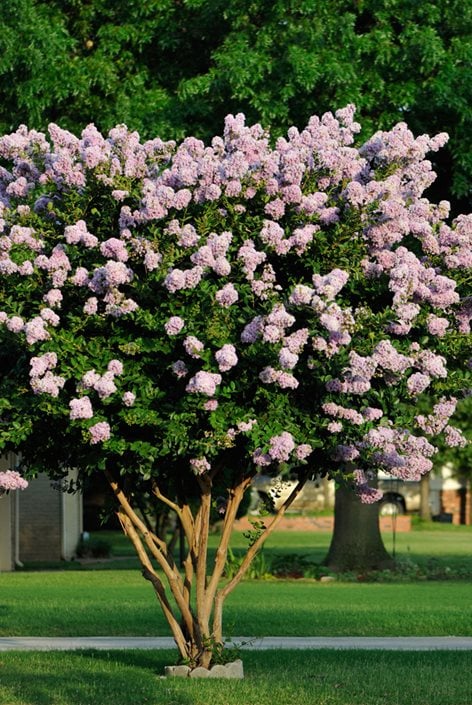The Myrtle Bush: A Lowmaintenance Beauty For Your Garden
The myrtle bush is a beautiful and low-maintenance plant that can add a touch of elegance to any garden. With its dark green foliage and fragrant flowers, the myrtle bush is a popular choice for both homeowners and landscapers.
In this blog post, we will discuss the different types of myrtle bushes, how to care for them, and the benefits of adding one to your garden.
Types of Myrtle Bushes
There are many different types of myrtle bushes, each with its own unique characteristics. Some of the most popular types include:
- Crape myrtle: Crape myrtles are known for their colorful blooms, which can range in color from white to pink to red. They are also relatively drought-tolerant, making them a good choice for gardens in hot, dry climates.

- Wax myrtle: Wax myrtles are evergreen shrubs that produce small, white flowers in the spring. They are tolerant of a variety of soil conditions and can withstand both heat and cold.
- Southern myrtle: Southern myrtles are native to the southeastern United States. They are hardy shrubs that can grow up to 10 feet tall. Southern myrtles produce small, white flowers in the spring and summer.

- Myrtle tree: Myrtle trees are large evergreen trees that can grow up to 30 feet tall. They produce small, white flowers in the spring and summer. Myrtle trees are native to the Mediterranean region.

Caring for Myrtle Bushes
Myrtle bushes are relatively easy to care for. They prefer full sun but can tolerate partial shade. They also prefer well-drained soil. Myrtle bushes should be watered regularly, especially during hot, dry weather. They should also be fertilized once a year in the spring.
Benefits of Adding a Myrtle Bush to Your Garden
There are many benefits to adding a myrtle bush to your garden. Here are a few:
- Beauty: Myrtle bushes are beautiful plants that can add a touch of elegance to any garden.
- Low maintenance: Myrtle bushes are relatively low-maintenance plants. They require little watering and fertilizer.
- Drought tolerance: Myrtle bushes are drought-tolerant plants. They can withstand long periods of dry weather.
- Heat tolerance: Myrtle bushes are heat-tolerant plants. They can withstand hot, humid summers.
- Attracts pollinators: Myrtle bushes attract pollinators such as butterflies and bees. This can help to improve the health of your garden.
- Fragrance: Myrtle bushes have a sweet, fragrant scent. This can make your garden smell wonderful.
Conclusion
The myrtle bush is a beautiful, low-maintenance plant that can add a touch of elegance to any garden. If you are looking for a plant that is easy to care for and will attract pollinators, the myrtle bush is a great option.
Myrtle bushes are beautiful evergreen shrubs that are native to Mediterranean Europe, North Africa, the Middle East, and Turkey. They are known for their fragrant white flowers and glossy green leaves. Myrtle bushes can grow up to 10 feet tall, but they are more commonly seen as smaller shrubs. They are relatively easy to care for and can be grown in a variety of climates.
If you are interested in learning more about myrtle bushes, I recommend visiting the website Garden Wiki. This website has a wealth of information about myrtle bushes, including their history, symbolism, and cultivation. You can also find articles on specific types of myrtle bushes, such as crepe myrtles and dwarf myrtles.
FAQ of myrtle bush
1. What is a myrtle bush?
A myrtle bush is a type of evergreen shrub or small tree that is native to the Mediterranean region. It has glossy, dark green leaves and clusters of small, white or pink flowers. Myrtle bushes can grow up to 15 feet tall and wide, and they are known for their fragrant flowers and foliage.
2. Where do myrtle bushes grow best?
Myrtle bushes are hardy in USDA zones 8-11, and they prefer full sun and well-drained soil. They can tolerate some drought, but they will not do well in wet, soggy soil. Myrtle bushes are also susceptible to frost damage, so they are not recommended for planting in cold climates.
3. How do I care for a myrtle bush?
Myrtle bushes are relatively easy to care for. They need to be watered regularly, especially during the hot summer months. They should also be fertilized once a year in the spring. Myrtle bushes do not require much pruning, but you can trim them back in the spring to shape them or to remove dead or damaged branches.
4. What are some common pests and diseases that affect myrtle bushes?
Myrtle bushes are susceptible to a few common pests and diseases, including scale insects, mealybugs, and aphids. These pests can be controlled with insecticidal soap or neem oil. Myrtle bushes are also susceptible to a fungal disease called powdery mildew. This disease can be prevented by watering the plant at the base and avoiding overhead watering. If powdery mildew does occur, it can be treated with a fungicide.
5. What are some of the benefits of myrtle bush?
Myrtle bushes have a number of benefits. They are beautiful plants that can add color and interest to any landscape. They are also fragrant plants that can be used to make potpourri or essential oils. Myrtle bushes are also said to have a number of medicinal properties, including antibacterial and antifungal properties.
Image of myrtle bush
5 different images of "myrtle bush" from Pinterest:
- A large myrtle bush with dark green leaves and white flowers.

- A close-up of the leaves and flowers of a myrtle bush.

- A myrtle bush in full bloom, with pink and white flowers.

- A myrtle bush in a pot, with dark green leaves and small white flowers.

- A myrtle bush growing in a garden, with dark green leaves and white flowers.

Post a Comment for "The Myrtle Bush: A Lowmaintenance Beauty For Your Garden"